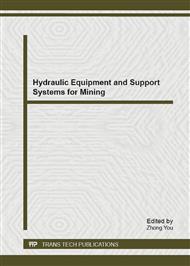
This paper aims at the problems of traditional compound pendulum jaw crusher including unreasonable structure design, heavy weight, low utilization of material and high cost, chooses moving jaw which is the key part of motion mechanism as the optimal design subject, uses finite element method, through statics analysis, obtains stress and displacement distribution of moving jaw that is under the action of maximum fracture force, realizes weak link and surplus part of primary structure. Based on the above-mentioned study, this article uses minimum weight of moving jaw as objective function, combines with structure characteristic of crusher, uses the ANSYS Parametric Design Language (APDL) to establish parameterization model, and combines with the optimal design module OPT, works out the minimum weight of moving jaw under the conditions of meeting intensity and stiffness. The result indicates that moving jaw is less than the original one by 27%, which saves material, reduces cost and weakens additional dynamic load that caused by inertial force of work mechanism, improves dynamics of mechanism to a cert extent, reduces the vibration of mechanism and the wear of part, and extends product service life.
You might also be interested in these eBooks
Info:
© 2013 Trans Tech Publications Ltd. All Rights Reserved
[1]
GeorgUnlalld, PiotrSzczelina. Coarse crushing of brittle rocks by compression. Mine ring Process. (2004), pp.209-217.
Google Scholar
[2]
B.X. Lang: Present Situation and Development of Jaw Crusher. Mining & Processing Equipment. Vol. 33(2004) No. 1, pp.9-10.
Google Scholar
[3]
C.L. Sun, Q.M. Lian and Q.F. Wang: Review and Prospect of Jaw Crusher. Non-ferrous Mining and Metallurgy. (2005) No. 7, pp.134-137.
Google Scholar
[4]
T. Jang, X.H. Xie, and H.S. Weng: Finite Element Optimal Design of Compound Pendulum Jaw Crusher. Coal Mine Machinery. (2007) No. 2, pp.11-13.
Google Scholar
[5]
T. Lv, C.D. Shi and Q.J. Zhang: Modal Analysis of Jaw Crusher Frame Based on ANSYS. Machinery Design & Manufacture. (2008) No. 11, pp.99-101.
Google Scholar
[6]
H.P. Luo, F.S. Mu and H.Q. Wang: Simulation Research on Double Jaw Crusher Based on ADAMS. Journal of Railway Science and Engineering. (2007) No. 4, pp.88-92.
Google Scholar
[7]
H.J. Chen, L.H. Wu and L.J. Zou: Application of ADAMS in Simulation and Optimization of Jaw Crusher. CAD/CAM Digital Manufacturing Industry. (2005) No. 11, pp.40-32.
Google Scholar
[8]
D.M. Huang, S.M. Jiang and C.L. Yang: Research on the impact of the toggle plate supporting position on the traveling characteristic value of moving jaw. Machinery Design & Manufacture. (2011) No. 1, pp.236-238.
Google Scholar
[9]
D.M. Huang, S.M. Jiang and C.L. Yang: MATLAB Optimal Design of Moving Jaw Parameters Based on Minimum Property Value. Machinery Design & Manufacture. (2012) No. 1, pp.4-6.
Google Scholar
[10]
D.M. Huang, C.L. Yang and S.M. Jiang: Dynamics Optimal design of Moving Jaw Based on MATLAB. Machinery Design & Manufacture. (2012) No. 3, pp.28-30.
Google Scholar
[11]
L.R. Ding, L.Q. Guo: Finite Element Optimal Design and Analysis of Compound Pendulum Jaw Crusher Spring Seat. Coal Mine Machinery. (2005) No. 9, pp.23-25.
Google Scholar
[12]
W. Huang, X.H. Liu and D.M. Huang: Finite Element Analysis and Optimal Design of Jaw Crusher Frame Based on APDL. Machinery Design & Manufacture. (2010) No. 12, pp.47-49.
Google Scholar
[13]
Robert D. cook. Concepts and Application of Finite Element Analysis. John Wiler & Sons. (1981).
Google Scholar


